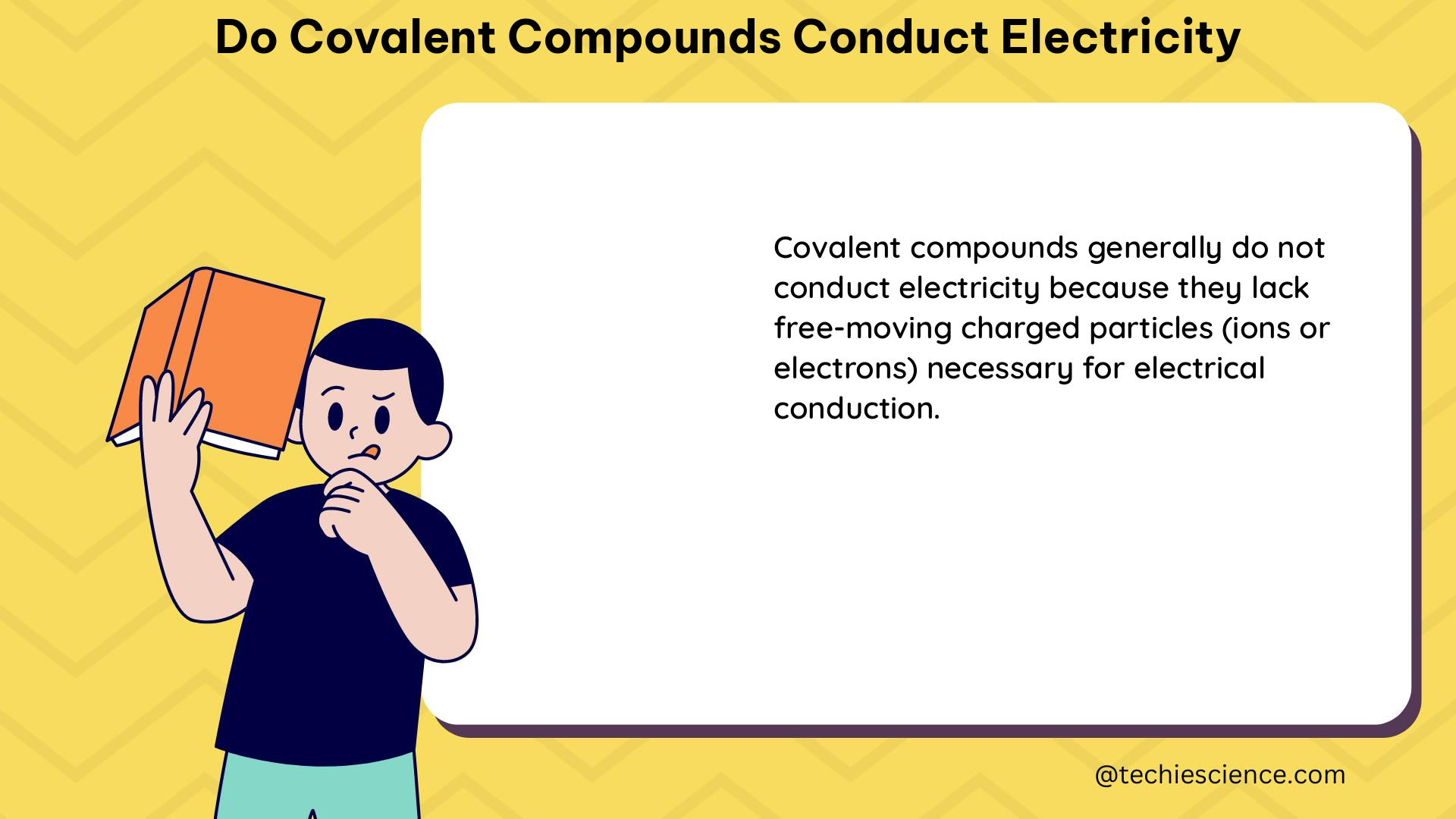Covalent compounds, in general, do not conduct electricity due to the sharing of electrons between atoms, which restricts the movement of electrons through the substance. However, there are some exceptions where covalent compounds can exhibit electrical conductivity, such as in certain polymers, graphite, and acids.
Understanding Covalent Bonds and Electrical Conductivity
Covalent bonds are formed when atoms share one or more pairs of electrons, creating a stable electronic configuration. This sharing of electrons is the defining characteristic of covalent compounds. The shared electrons are not free to move through the substance, which is why most covalent compounds are poor conductors of electricity.
The ability of a material to conduct electricity is determined by the presence of free charge carriers, such as electrons or ions, that can move through the substance under the influence of an electric field. In ionic compounds, the presence of free-moving ions allows for electrical conductivity, while in metallic compounds, the presence of free-moving electrons enables conductivity.
Exceptions: Covalent Compounds that Conduct Electricity

Despite the general non-conductive nature of covalent compounds, there are a few exceptions where these compounds can exhibit electrical conductivity:
Doped Polymers
Polymers are long-chain molecules composed of repeating covalent units. While pure polymers are typically insulators, their conductivity can be enhanced through a process called doping. Doping involves the introduction of small amounts of impurities or dopants into the polymer structure, which creates “holes” in the electronic structure. When an electron jumps into a hole, a new hole is created, allowing charge to move through the substance.
The conductivity of doped polymers can vary widely, with some polymers having conductivities in the range of semiconductors, typically between 10^-6 to 10^4 S/m (Siemens per meter). The specific conductivity of a doped polymer depends on the type and concentration of the dopant, as well as the polymer’s molecular structure.
Graphite
Graphite is a covalent compound composed of layers of carbon atoms, with each carbon atom forming three covalent bonds within the layer and one delocalized electron. This delocalized electron allows for the movement of charge carriers, resulting in graphite’s ability to conduct electricity.
The conductivity of graphite is in the range of semiconductors, with a value of approximately 10^4 S/m. This makes graphite a useful material in various electronic applications, such as electrodes, brushes, and conductive coatings.
Acids
Acids can also conduct electricity when they ionize in solution, producing free-moving ions. This conductivity is not a property of the covalent bond itself but rather a result of the ionization process. When an acid, such as hydrochloric acid (HCl), dissolves in water, it dissociates into hydrogen ions (H+) and chloride ions (Cl-), which are free to move and conduct electric current.
It’s important to note that the conductivity of acids is not a direct consequence of the covalent bonds within the acid molecules, but rather a result of the ionic species formed during the ionization process.
Technical Specifications and Numerical Examples
Technical Specifications
- Covalent compounds, in general, do not conduct electricity due to the sharing of electrons between atoms.
- Certain exceptions exist where covalent compounds can conduct electricity, such as in certain polymers, graphite, and acids.
- The conductivity of doped polymers can vary widely, with some polymers having conductivities in the range of semiconductors (10^-6 to 10^4 S/m).
- Graphite has a conductivity of approximately 10^4 S/m due to its free electron.
- Acids can conduct electricity when they ionize in solution to produce ions.
Physics Examples
- A simple experiment to demonstrate the non-conductivity of covalent compounds is to use a multimeter to test the conductivity of a substance like sugar or baking soda. These substances are covalent compounds and will not conduct electricity.
- A more advanced experiment to demonstrate the conductivity of doped polymers would be to create a sample of doped polyacetylene and measure its conductivity using a multimeter or other electrical measurement device.
Physics Numerical Problems
- A polymer has a conductivity of 10^-3 S/m. What is the resistance of a 1-meter long sample with a cross-sectional area of 1 cm^2? (Resistance = resistance per unit length x length / cross-sectional area)
-
Resistance = (1 / 10^-3 S/m) x (1 m) / (1 cm^2) = 1000 ohms
-
A sample of graphite has a conductivity of 10^4 S/m and a length of 0.1 meters with a cross-sectional area of 0.5 cm^2. What is the resistance of the sample?
- Resistance = (1 / 10^4 S/m) x (0.1 m) / (0.5 cm^2) = 2 ohms
Figures, Data Points, Values, and Measurements
- The conductivity of doped polymers can vary widely, with some polymers having conductivities in the range of semiconductors (10^-6 to 10^4 S/m).
- Graphite has a conductivity of approximately 10^4 S/m due to its free electron.
- A 1-meter long sample of a polymer with a conductivity of 10^-3 S/m and a cross-sectional area of 1 cm^2 would have a resistance of approximately 10^6 ohms.
- A sample of graphite with a conductivity of 10^4 S/m, a length of 0.1 meters, and a cross-sectional area of 0.5 cm^2 would have a resistance of approximately 2 ohms.
Reference:
- How to test if some unknowns are covalent or ionic
- Covalent Bond
- How do covalent compounds conduct electricity?
- Why can covalent compounds conduct electricity?
- Chem 111 Smart Book 9 Flash Cards
Hi…I am Ankita Biswas. I have done my B.Sc in physics Honours and my M.Sc in Electronics. Currently, I am working as a Physics teacher in a Higher Secondary School. I am very enthusiastic about the high-energy physics field. I love to write complicated physics concepts in understandable and simple words.